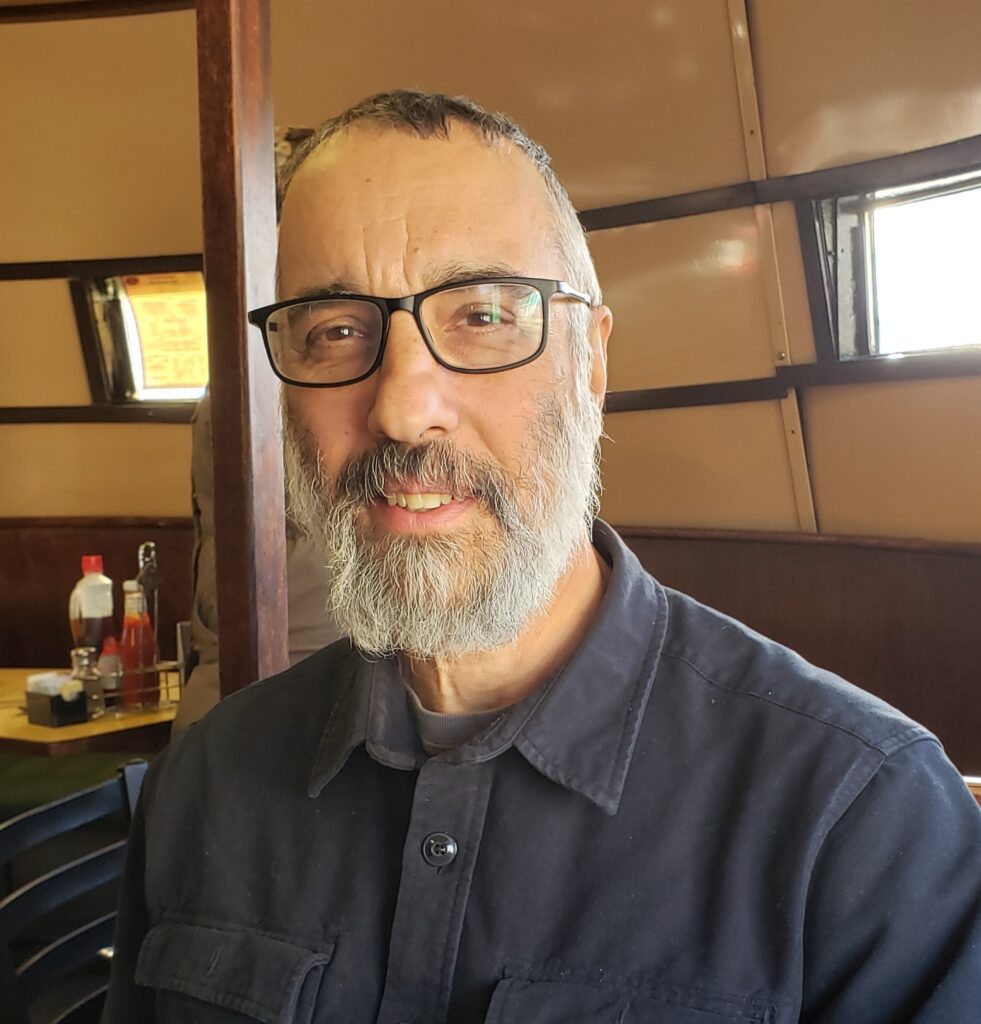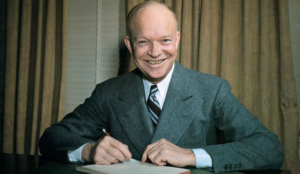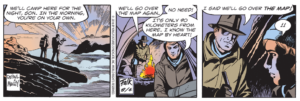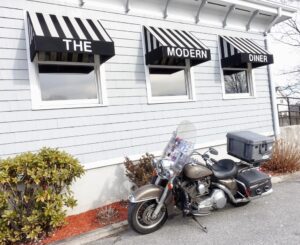
The discussion I had with Tony that afternoon in East Providence, Rhode Island at Lucky’s was far ranging. We talked about writing in all forms—journalism, comics, screenplays and nonfiction, for example. We talked about  some of his motorcycle travels. About family. The Sixties. Maine. Vietnam. Stephen King. Dave Bright.
some of his motorcycle travels. About family. The Sixties. Maine. Vietnam. Stephen King. Dave Bright.
With our lunch and conversation ending, the bill for the meal and drinks was paid. We went out the front door of the bar & grill and walked onto the parking lot over to Iron Piggy. A steady wind beat against us as we were standing next to the Harley, 2004 Road King Classic.
Three separate sets of customers walked by us heading inside the bar. All young men and biker fans, they were nevertheless driving and riding in cars. My cell phone was registering an outside temperature of 23 degrees Fahrenheit. Each one that passed us said that it was just too brutal out to be riding that day. They said so with grudging admiration at Tony’s determination to be out on a bike in such weather anyway.

Iron Piggy and leads (Photo courtesy and permission of Tony DePaul.).
Tony was prepared for riding that day. I noticed that he had 12–volt leads running out of his leather jacket that he plugs into the bike. Later on in an email to me, Tony explained that the leads “draw power off the charging system to heat my gloves and jacket liner.”
Nevertheless, I was glad I was in a car and not riding a motorcycle. It was cold. Yet, Tony seemed stoic about it, blustery out or not, as if it was something that he expected, was used to experiencing, and even happy to be outdoors in such weather.
Over the next several days we communicated via email and arranged to meet again on Monday morning, January 28th,at the Modern Diner on East Avenue in Pawtucket, Rhode Island.

The Modern Diner at 364 East Avenue, Pawtucket, RI. According to its website, “The Pawtucket restaurant was chosen to be the first diner in the nation to be accepted on the National Register for Historic Places. Customized and factory-built, it is a Sterling Streamliner, a line of ‘modernistic’ diners manufactured in the late 1930’s and early 1940’s.”

On a fairly decent winter morning, I drove over to the restaurant to meet with Tony. Blue sky could beseen overhead, but it was laced with a skim of cirrostratus clouds, which cut into the brightness of the sunlight. The parking lot was full of cars and pickups. A large line of people waiting to get into the restaurant snaked out the entrance door, down the steps to it and onto the asphalt portion of the parking area. We were in line for about 25 minutes.
Iron Piggy and leadsStanding in line, I did a quick retrospective of what I had learned about Tony’s writing career. For 26 years, he was a newspaper reporter, first for the Bangor Daily News (1980 through the fall of 1986) and then for The Providence Journal (1986 to April 2006). For 26 years he ground out articles for these two New England newspapers. That’s a longtime witness to humanity, particularly to culture, crime, chicanery and corruption. I am positive that he caught an amazing glimpse into all kinds of foibles and follies people commit and/or omit, as well as writing and being exposed to powerful human interest stories.
I wanted to be sure to talk with him about his experiences in writing comics and his take on storytelling.
Right side view of the diner. (Photo courtesy and permission of Tony DePaul.) Iron Piggy is parked just to the right of the light gray annex.
When it was our turn to be seated, the waitress escorted us to a booth at the right front side of the diner. After taking my coat off and putting it on a coat hook next to me, I took my laptop out and set it up in preparation for note-taking.
When it was our turn to be seated, the waitress escorted us to a booth at the right front side of the diner. After taking my coat off and putting it on a coat hook next to me, I took my laptop out and set it up in preparation for note-taking.
The waitress introduced herself, and took our drink order. Tony and I started talking about his writing for the comic strip The Phantom. He told me that since the early 60s, as soon as he was old enough to be literate, he started reading the comic strip in his local newspaper, which was the Philadelphia Bulletin (published between 1847 to 1982).1

(“That’s it for me and the Phantom,” May 31, 2017). (Photo courtesy and permission of Tony DePaul.)

Tony explains this Phantom “encounter” as follows (“That’s it for me and the Phantom,” May 31, 2017).
“It all started circa 1959, when America liked Ike. I was vaguely aware of his mug on the front page, but the Phantom, way inside the paper, was the one and only reason this grubby little street kid snatched the Philadelphia Evening Bulletin off the front steps. What great fun, in that concrete–and–asphalt world, to spread out the paper on the living room floor and imagine adventures in a jungle over the far horizon.”
In the early 1990’s, he wrote for several comics in the Swedish Fantomen2 comic book, including”The Phantom“.3 Because of this experience, he had the opportunity to take over the Phantom daily4 and Sunday strip.5
He wrote stories for the comics “Dödsspelet” and “Det okända” for Fantomen, both illustrated by Kari Leppänen.6
The waitress returned with our drinks. We ordered breakfast, and after the waitress left with our grill order to give to the short order cook, Tony explained more at length about the genesis of his comic strip writing.

“Both front brake rotors are ready for the scrap heap. They mic at .182, within spec by two thou. Any thinner than .180 and they’re done.” (“Honey I blew up the iron piggy,” October 13, 2017) (Photo courtesy and permission of Tony DePaul.)
The Phantom, started by Lee Falk7 (April 28, 1911–March 13, 1999) when he was 25, first appeared in a daily newspaper strip on February 17, 1936. A color Sunday strip of the series started in May of 1939. The Phantom was the world’s first superhero.
The Phantom also was the “first to wear the skintight costume that has become a hallmark of comic–book superheroes, and the first to wear a mask with no visible pupils, another  superhero standard.”8
superhero standard.”8
After Falk died from heart failure, Hearst Communications9 / King Features Syndicate [KFS] held tryouts for a writer to replace Lee Falk, who had written this strip on a daily basis for an amazing 63 years. Tony explains this moment in time by saying that these tryouts were “for a couple of us who were writing 30-page Phantom yarns [generally eight panels per page] for Fantomen, a Swedish comic licensed by KFS. By the summer of 2000, KFS had made its choice: I had the job writing The Phantom for newspaper syndication around the world.”10
Upon being hired to such an incredible storytelling gig, his assignment was “to create five stories a year, more or less. Standard lengths are 18 weeks daily, 26 weeks Sunday. They can run longer, shorter, whatever it takes or less. Standard lengths are 18 weeks daily, 26 weeks Sunday. They can run longer, shorter, whatever it takes to tell the tale, but figure roughly three stories a year for the daily papers, two for Sunday papers.”11

Sample panel from a published August 1-6, 2016 strip. Story by Tony and artwork by Mike Manley. “The Phantom’s son, Kit Walker, is off to a secondary school in the Himalayas, where he’ll attempt to pass himself off as a student who spent two other lives at the school, in the 19th and 18th centuries.” (Photo courtesy and permission of Tony DePaul.)

Next morning, following the Clark Fork. This is probably Montana. We had camped just a few miles west of the state line. (“High Plains Drifting,” July 29, 2013. Photo courtesy & permission of Tony DePaul.)
He explained more fully to me about this writing opportunity. “Our editor in Stockholm, Ulf Granberg, basically volunteered us for tryouts. I don’t remember seeking the job on my own.
“In the early 90′, a friend of mine who was big into comics introduced me to an editor at Semic Press in Stockholm, and things went from there. I seem to think it was a female editor he had worked for. I never did get any work from her, but somehow she passed me on to Ulf and he asked me to submit a few ideas for Phantom stories. In a year or two the work became steady, and Ulf became a family friend. He’d fly over to visit from time to time.”
I think it is fascinating that an experienced newspaper reporter turned his hand to writing comics as it seems on the outset to be such a wide disparity of venues. Yet, listening to Tony talk about his experiences in writing, his wide–ranging interests and motorcycle journeys on the Iron Piggy, his love of family, carpentry skills, and his innate sense and consummate ability to fix all things mechanical, I truly began to sense that here was someone with a keen appetite for investigating what scholars call the human question.12

After all, I asked myself, doesn’t Tony’s triple literary threats—a natural literary giftedness, a creative, inquisitive spirit, and over two–and–a–half decades of newspaper reporting—provide an excellent grounding for writing stories for the comics, especially for the Phantom?13
As I was thinking about this aspect of storytelling and its relevance to Tony, our kind waitress returned to our table and served us our breakfast orders.
When he was asked in an interview conducted by Steffan Hope, what Tony thought about “the Phantom as a literary figure,” Tony responded by saying,

A panel from the 38-week story from The Phantom titled, “A Reckoning with the Nomad.” (“Consider the infamous Nomad reckoned with!” November 10, 2018. Photo courtesy & permission of Tony DePaul.)
“He’s a pure archetype, the selfless hero who braves any danger to do right, and never resorts to doing wrong as a means to accomplish an objective. That’s awfully old–fashioned today, but I like it. What makes the Phantom notable, of course, is the immortality myth. If Lee Falk hadn’t hit on that angle, the Phantom might have faded into obscurity in the 1940s.”14
Tony has also explained about this style of writing in one of his blogs as noted below:
“Writing for comics is a lot like writing for film. You’ve seen movie storyboards. In comics, you’re basically doing the same thing, stringing together snapshots of a story, panel by panel, advancing a narrative, creating continuity, dialogue, art direction when there’s a reason for it (usually to avoid getting tripped up on continuity issues that lie ahead).
“Comics may look like a few words on a page, but it takes a fair amount of information to get them there. I think I probably wrote 5,500 pages of script over the years. The script for my current daily story is 100 pages. It describes 425 panels in sequence, published 2 or 3 panels a day for 28 weeks.

“Reassembling the gear set[to Iron Piggy] after pressing new bearings in the side door.” (“In the home stretch,” February 29, 2012. Photo courtesy & permission of Tony DePaul.)
“Between the overseas books I started writing in 1990 and the newspaper strips in ’99, I’ve worked with maybe two dozen artists around the world. Everyone is different, different temperament, some will wow you every time, some need their hand held. The best ones, you mostly just leave them alone. All they need to know from the writer is where the characters are in a given panel, what they’re doing, what that setting is like, time of day, what the characters say, what they know, and what they think and feel about what they know.” 15
Even though he has not written for “the overseas books in going on 20 years now. Haven’t written original stories for them, I should say; they often republish the stories I write for King Features.
Why did he decide to write for them? His response is, “The overseas books were a great opportunity way back when. My wife was home with the kids in those days, we were carrying a killer mortgage, I was delighted to have a steady freelance gig on the side.”
I asked Tony eight questions about his writing for a comic strip and about his writing in general. Here are the questions I asked and his responses to them below:
(1.) A lot of people who love comic books start when they’re young. Was that the case for you?
I can’t say I love comic books. I love sequential art—I think in sequential art—but I’ve never been in the comics business. I don’t collect comics, don’t go to comics stores, don’t go to comic con. I came to The Phantom gig out of screenwriting and daily journalism. Which is kind of a logical approach, really. Screenwriting is an exercise in sequential art, and it was newspapers, after all, that brought  The Phantom to untold millions of readers around the world. I read comics when I was a kid up to around age 12, but I’d have to do an awful lot of work to be able to write any of those superhero characters. The Phantom is the only comics character I know, and the only one that interests me. I think that’s because Lee Falk and the great Sy Barry made such a lasting impression on me when I was a kid. I was a complete sucker for the world they created for us street urchins every day in the Philadelphia Evening Bulletin.
The Phantom to untold millions of readers around the world. I read comics when I was a kid up to around age 12, but I’d have to do an awful lot of work to be able to write any of those superhero characters. The Phantom is the only comics character I know, and the only one that interests me. I think that’s because Lee Falk and the great Sy Barry made such a lasting impression on me when I was a kid. I was a complete sucker for the world they created for us street urchins every day in the Philadelphia Evening Bulletin.

Headed north through the valleys between the Bighorns and the Rockies. Horses range down low, Bad Mr. Grizz up high.” (“Alaska!” February 5, 2014. Photo courtesy & permission of Tony DePaul.)
(2.) What do you do to recharge your creative batteries?
They’re always charged. I’ve never experienced writer’s block, never felt even a hint of burnout. Ideas are everywhere. I always say they streak in like space rocks. Most aren’t good ideas, but when you’re bombarded at all hours all you really have to do is pay attention and know a good one when you see it.
(3.) Describe your typical work routine.
“I’m all over the map, sometimes literally. I can think of stories I’ve worked on in a dozen different states, wherever I can set the motorcycle on the kickstand and mooch a wi–fi signal. But even here at home, there’s no real routine. Some days I’ll write for untold hours, get into the flow state and lose track of time. That’s always weird. I’ll think I’ve been writing for 90 minutes, but the clock tells me it’s been five hours. Other days I might write for 30 minutes, break for household things that need to get done, and while I’m doing those things I’m mentally still working on the writing, even if I’m not aware of it. I might write, dig a hole in the ground, write, chop firewood, write, change oil on one of vehicles, write, run an errand, write . . . before you know it the day’s over, time to fall asleep and work on stories subconsciously all night.

Self-reflection. Photo courtesy and permission of Tony DePaul (28 January 2019).
(4.) What tools do you use to create comics and what makes them the right tools for you?

Here Tony is building a new storage shed. “But up it went, all plumb & square, one-armed-paperhanger style. Had a few adventures, as on November 6, during an all-day rain, up on a slippery plank trying to place 4 by 8 sheets of wet plywood and get a nail in each before gravity intervenes.” (“Where the advent of Winter finds us.” November 18, 2014. Photo courtesy & permission of Tony DePaul.)
All I need is a coffee pot and FinalDraft, the screenwriting software. I use it because I’m fast with it. And, as I said earlier, writing for comics is hard to distinguish from screenwriting. So many movies are basically comic books in how they see the world, how they define the characters, frame the action, the point of the action, how they answer all the who–wants–what questions, and why. These are movies not remotely associated with comics culture, but their narratives would be right at home in a comic. As for movies based on comics characters, those are generally beyond awful, in my opinion. You can’t tell them from video games anymore. I’ve stopped trying to watch them.
(5.) What element of your work gives you the most personal satisfaction?
The last three percent. That’s where you start to see connections you never suspected were there. It’s that last little bit of thinking, seeing and appreciating the pattern in the whole, rearranging the pieces, this goes here, that goes there, adding depth, adding color, adding fun. A story I file because it’s time to file, but I know it has only 97 percent behind it, that story, to my eye and ear, feels one–third as good as a story truly finished and thoughtfully edited.

Lake Cushman is a 4,010-acre lake and reservoir on the north fork of the Skokomish River in Mason County, Washington. “Here’s the view when you turn your back to the jet boat. Man, am I gonna miss waking up to this.” (“Goodbye to the Pacific.” July 15, 2013. Photo courtesy & permission of Tony DePaul.)
(6.) What has been the most rewarding project in your professional career?
The stories that will never see the light of day. All the stuff I’ve scribbled for a paycheck, a freelance payday, everything I was paid to do as a wage slave, a working stiff, an entrepreneur, that’s the run of the mill. It’s just what you do day in and day out if you’re a professional. Somebody’s paying you to write, so you write, and make it as good as you possibly can on deadline. It’s honorable, it’s necessary, but it’s never been what I find most rewarding.
(7.) What’s the best advice you’ve ever heard given to a promising new creator?
Nada. I’m sure it’s been said somewhere but I’ve never heard it. I’ve never had a dime’s worth of good advice from anybody. Never any mentoring or anything like that. Consequently, the only advice I have to give is what I found out on my own: carry a notebook at all times. Use it.
(8.) Time to get philosophical: What’s the most important “big idea” that you’ve learned in life—in or out of comics—and why is it important?
 Oh, I knocked this one out of the park 43 years ago: Marry the right person. If you mess that up, you’re screwed.
Oh, I knocked this one out of the park 43 years ago: Marry the right person. If you mess that up, you’re screwed.
Notes:
• Featured photo taken by A. Keith Carreiro (28 January 2019).
• For your listening pleasure, please check out this podcast < “X-Band: The Phantom Podcast – Episode 95: Interview with Tony DePaul” >. It is about a two–hour, 24 minutes interview and covers a lot of territory. Thanks to the folks at chroniclechamber.com for permission to post this podcast on my weblog.
• Please take a look at artist Mike Manley’s web links listed below:
http://www.drawman.blogspot.com
http://www.michaelcolemanley.com
Footnotes:
1https://en.wikipedia.org/wiki/Philadelphia_Bulletin
The Philadelphia Bulletin was a daily evening newspaper published from 1847 to 1982 in Philadelphia, Pennsylvania. It was the largest circulation newspaper in Philadelphia for 76 years and was once the largest evening newspaper in the United States. Its widely known slogan was: “In Philadelphia, nearly everybody reads The Bulletin.”
2https://web.archive.org/web/20100623085435/http://www.schapter.org/wiki/Fantomen
3https://web.archive.org/web/20100618142826/http://www.schapter.org/wiki/The_Phantom
4https://web.archive.org/web/20111003002947/http://www.schapter.org/wiki/Daily_stories
5https://web.archive.org/web/20101113230232/http://www.schapter.org/wiki/Sunday_stories
6https://web.archive.org/web/20110728003934/http://www.schapter.org/wiki/Kari_Leppänen
7https://en.wikipedia.org/wiki/Lee_Falk See also, http://thephantomcomics.com/lee-falk/
8https://web.archive.org/web/20100618142826/http://www.schapter.org/wiki/The_Phantom
See also, https://www.britannica.com/topic/Phantom-comic-book-character
9https://en.wikipedia.org/wiki/Hearst_Communications See also, https://www.hearst.com/
10http://www.tonydepaul.net/thats-it-for-me-and-the-phantom/
11http://www.tonydepaul.net/thats-it-for-me-and-the-phantom/
12http://mentalfloss.com/article/50787/29-answers-question-what-human-being
13https://www.britannica.com/topic/Phantom-comic-book-character
14https://web.archive.org/web/20070927211338/http://fantomet.org/hele_nyhet/id/142/
15http://www.tonydepaul.net/thats-it-for-me-and-the-phantom/
Disclosure of Material Connection: I have not received any compensation for writing this post. As the sole author of the Penitent – Part I, and the Penitent – Part II, and as the sole proprietor of Copper Beech Press, I have a material connection to these books, as well as to the publishing press, I have just listed. Other than my previously stated novels and publishing press, I have no material connection to the brands, products or services that I have mentioned here. I am disclosing this information in accordance with the Federal Trade Commission’s 16 CFR, Part 255: “Guides Concerning the Use of Endorsements and Testimonials in Advertising.”
© 12 March 2019 by A. Keith Carreiro
For information about my series, The Immortality Wars, please go to my home page: https://immortalitywars.com/


